- First Thing First: What Does Product Description Mean?
- Why Write Product Descriptions Is Relevance?
- 10 Rules for Writing a Product Description
- Rule 1: Keep in Mind Your Target Audience When Writing
- Rule 2: Detect the Format That Fits for You
- Rule 3. Tell Your Product Story
- Rule 4. Add High-Quality Product Images and Videos
- Rule 5. Keep In Mind the Product Benefits More Than the Product Features
- Rule 6. Write In an Informal or Casual Tone
- Rule 7. Use Power Words That Stimulate Readers’ Senses
- Rule 8. Try To Be as Specific as Possible
- Rule 9. Include Testimonials, Reviews, or Comments.
- Rule 10. Create SEO-Friendly Descriptions
- Some Things to Remember When Writing Product Descriptions
- Final Thoughts!
- Frequently Asked Questions
Writing product descriptions is more than just copying and pasting features, dimensions, and technical details. Remember that they are a critical factor in arousing the interest of your audience and achieving conversion.
Discover the ten key rules to write product descriptions that invite your store visitors to click on buy.
Read on!
First Thing First: What Does Product Description Mean?
Product descriptions are content marketing texts explaining what a product is, what it is for, the benefits and why you should buy it. The goal of a description is to give visitors, and customers, all the relevant information about the key features and advantages of purchasing a product, so that they feel inclined to buy it.

It is the key to this type of content; a well-written product description awakens the consumer’s need to buy and guides them to the final part of your sales funnel, “the conversion.” The ideal product description combines persuasion, creativity, and entertainment to get your visitors hooked and close a purchase and the holy grail “customer loyalty.”
To help you succeed in your product description process, here are some questions that your text should answer for your target customers:
- What need does your product satisfy?
- What benefit does your product have for the customer?
- What distinguishes your product from the other options available in the market?
Now that you are clear about product descriptions’ definition and purpose let’s look at their relevance!
Why Write Product Descriptions Is Relevance?
According to OneSpace, 50% of shoppers have returned an item they purchased online because it did not match the product description.
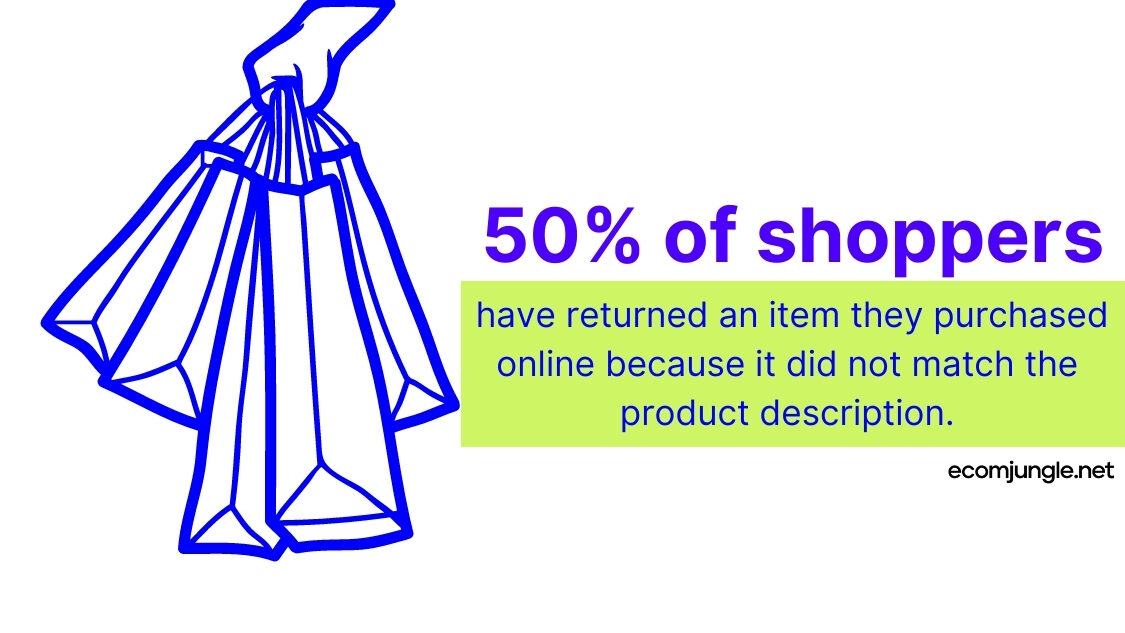
- Improve conversion rate: yes, compelling product descriptions help you, provide the key information your target audience is looking for to decide to buy, and ultimately help you close more sales.
- Attract quality traffic to your store: the correct content of a product description offers complete information with attractive visual supports and text elaborated for SEO, which helps you. Remember, the goal of a product description is to use power words to get visits from those users who want to know or buy products like those you offered on your store so that they stay on your site and you can reduce the bounce rate.
- Provide a better browsing and shopping experience to your customers: If the product descriptions text is engaging and hits on target by exposing the customer’s need and the advantages offered by your site, look professional, and the user understands that you know what you are talking about.
- Competitive advantage: Finally, another point in favor of eCommerce product descriptions is that they help you to find out what your products have that your competitors do not.
10 Rules for Writing a Product Description
It’s time to get down to work and see one by one the rules to elaborate a good product description that sells and help you position your eCommerce site.
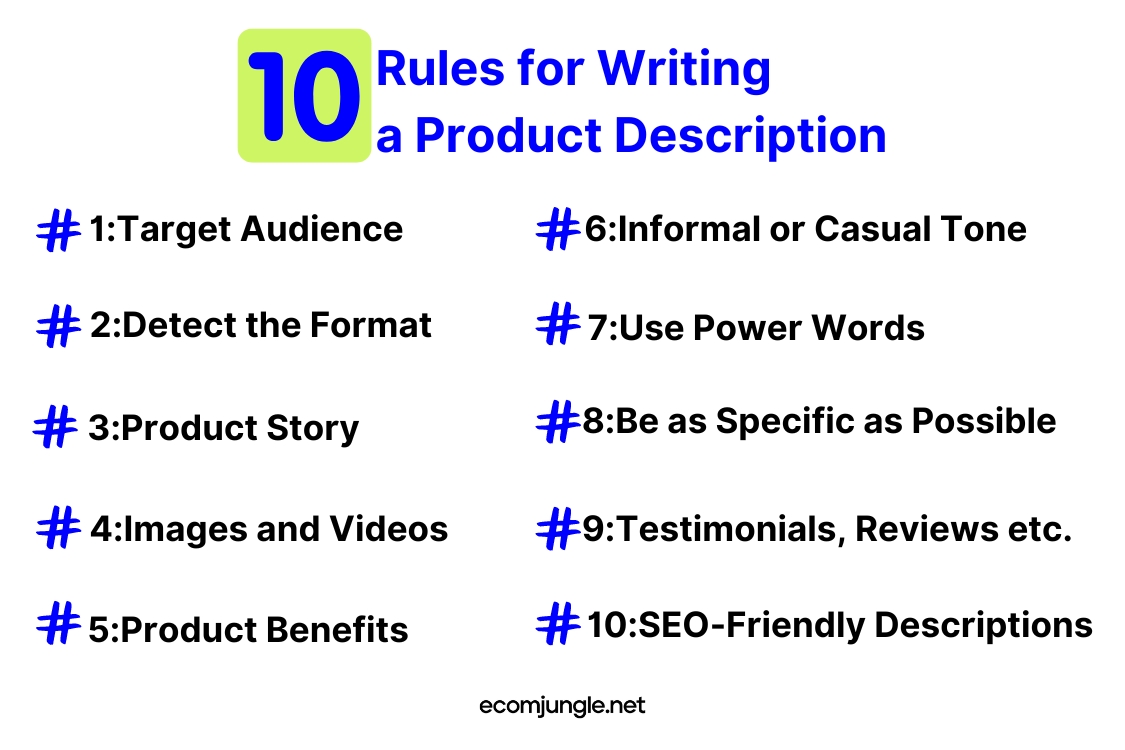
Let’s get started!
Rule 1: Keep in Mind Your Target Audience When Writing
The first thing you should do when writing a product description is to think about who your buyer persona is and who your products are aimed at. To create good content, you must put yourself in the shoes of your ideal customer so that your text is precise and focused on their needs.
To do this, you must define the profile of your buyer persona and take into account key data such as their:
- Age.
- Location.
- Gender.
- Interests.
- Education.
In addition, you must consider these questions during your product description creation process:
- How did the visitor get to your site?
- What interests the customer?
- Why would the visitor want to buy from your online store?
- Which of your product features would engage your customer?
These questions help you to be more prepared to create a product description that motivates sales; you are talking directly to your potential customers, using their language.
Pro Tip:
Avoid creating content in masse, thinking of hundreds of people, that only makes the product descriptions vague, imprecise, and does not respond to the interests and needs of the public.
Rule 2: Detect the Format That Fits for You
If you are looking for a format that fits all your product descriptions that makes them look like part of a whole, for example, using bullet points to list the features and dimensions of your products is ideal, as it makes your content easy to read and digestible. Those details are understandable to your audience.
Try to keep your product descriptions light without losing quality; I recommend using short paragraphs to explain why your product is worth buying.
Take your time, find that voice that identifies your brand and let it take the lead in the narrative.
While this may take some time, use a product description template available online. The result will be worth it.
To find out how to create marketing copy for your website, check my article about finding blog ideas.
Rule 3. Tell Your Product Story
Yes, telling a story in your product description is a powerful marketing tool, showing what’s behind each product. It is ideal for showing the customer why it is interesting, how the idea came about, the obstacles in your production process, the innovative solution you found to overcome them, the tests you performed, and how you finally got it to market.
Communicating these details to your audience helps to give personality and character to your content and allows customers not to feel that you are only focusing on selling them a product.
Rule 4. Add High-Quality Product Images and Videos
To write persuasive product descriptions, ensure high-quality visual support as part of your content. Remember that they help highlight the essential attributes of each product.
Product photos are a valuable resource, especially if the descriptions are very long; they help make the content easy to understand.
Videos can also be a great support, as they help the customer understand the product and how to use it.
Pro Tip:
Look for a professional photographer to take pictures of your products. They will know how to take the best shots for your products and give the visitors the sensation that they have the product in their hands.
Rule 5. Keep In Mind the Product Benefits More Than the Product Features
Remember that when reading a product description, your potential customers want to know how it will benefit them, make their life easier, and solve a problem. That’s why your content should focus on just that, highlighting each product feature’s benefits.
Please give them a detailed description! It is good not only to limit yourself to offering the composition of the materials and technical details but to add words that suggest to the buyers and help them to imagine themself enjoying the product.
New or more complicated-to-use products will need a more extensive description.
Only listen to people who tell you that people want to read long texts.
The reality is quite different.
According to PRNewswire, 98% of shoppers have been dissuaded from completing a purchase because of incomplete content.
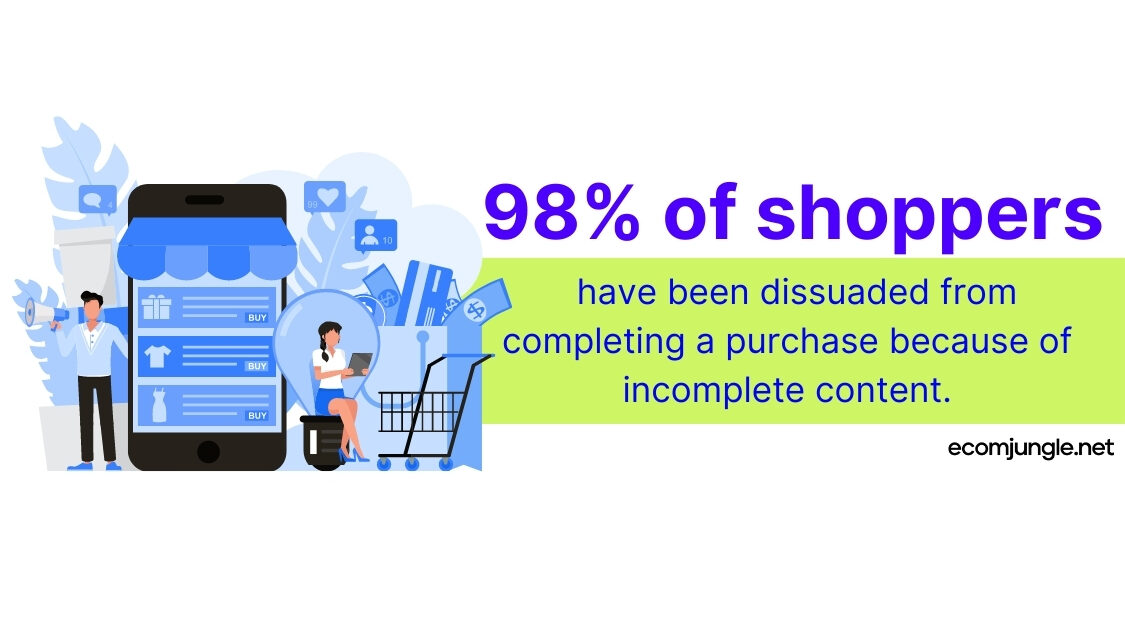
We read as much as it takes when we are interested in something, especially when we have doubts before buying.
So please make sure your shoppers are confident and answer all of them in your description.
Pro Tip:
Select two or three features of the product that you consider most striking and attractive to highlight its benefits.
Rule 6. Write In an Informal or Casual Tone
When you start writing, imagine that you are in front of your ideal customer, talking about every detail of your product. Try to be specific, focusing on the product’s most relevant features and advantages.
Try to use a natural tone that resembles a fluid conversation that allows the prospective customer to click with your brand and achieve a more profound connection that will motivate them to choose your products over others.
Also, I recommend you to be sincere in your statements, don’t use those typical infomercial phrases “more popular,” “cheaper,” “never gets damaged,” or “prettier” if you have no way to prove them.
Don’t resort to exaggeration to talk to the public!
Rule 7. Use Power Words That Stimulate Readers’ Senses
At this point in your creative process, sensory words can help you better encourage or motivate your potential customer and awaken an emotional response in them.
Examples of this include adjectives such as wonderful, exciting, amazing or impressive, surprising, and attractive. They can help you convince better your potential buyer so you must have those persuasive words in your product descriptions.
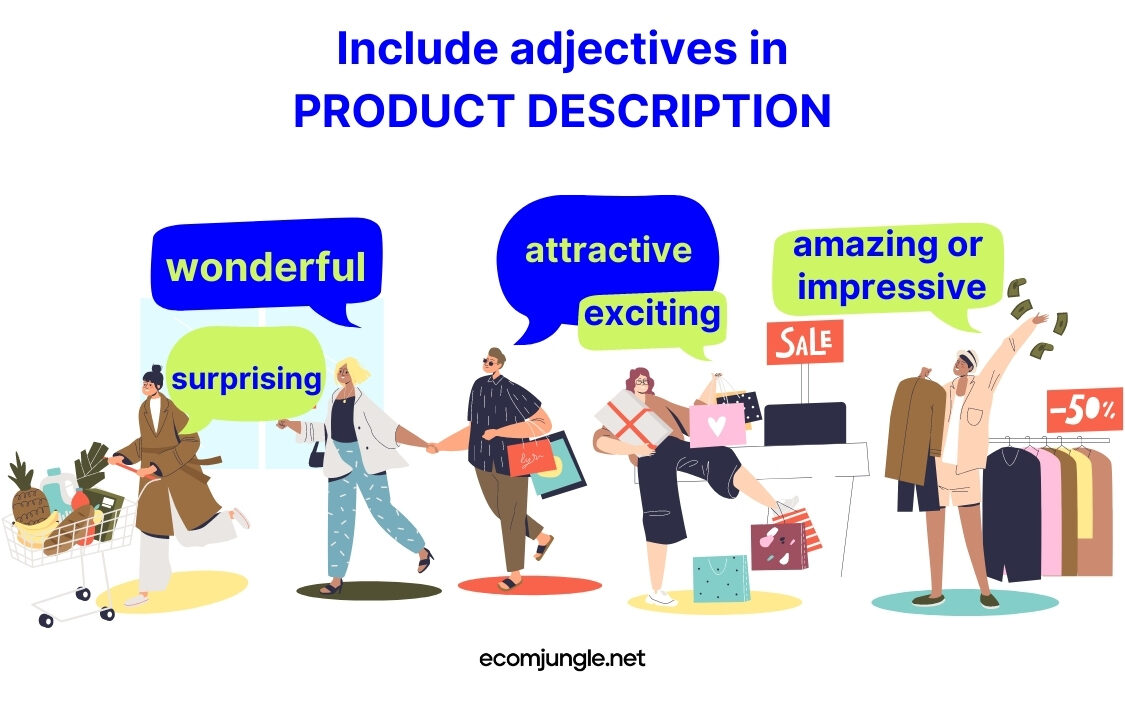
However, use them sparingly; use those that help reflect the style and image your brand seeks to project.
Remember that your descriptions should integrate harmoniously with the rest of your marketing efforts and your brand concept.
Rule 8. Try To Be as Specific as Possible
According to Shopify, 10% of eCommerce sites have product descriptions that are insufficient for users.

So I recommend you forget about using those generic phrases like “100% quality” that your prospective customers have seen repeatedly in different product advertisements and focus on product details. Remember that the intention is to make your products stand out. For that, you must be specific and describe point by point what makes your product quality, for example: what materials it is made of, the manufacturing process, and the quality standards or tests it has passed. These are the details that positively capture the public’s attention.
Back up your claims with concrete details, mainly if your eCommerce store is dedicated to selling technology products where customers require more information.
If you already have a site up and running and, after reading your existing product description, your customers still need more information. This red flag tells you to work even harder to improve your description and add necessary product details.
Remember that customers often prefer to ask for fewer details, and if your content asks them to make a bigger effort, they are likely to look for that information elsewhere.
Rule 9. Include Testimonials, Reviews, or Comments.
Often visitors to your online store are unsure about what product to buy, so they look for reviews or comments from past customers. The great thing about including social proof in your product pages is that it has a more significant impact on the audience because it tells prospective buyers to follow the path others have already taken.
Buyers are often more inclined to purchase products with the highest number of positive reviews or comments from their buyers.
Keep in mind that buyers like popular or in-demand products, so in addition to including reviews, you point out which products are top sellers or favorites of your customers if you can integrate the comments left by your followers in social networks much better to share success stories.
Rule 10. Create SEO-Friendly Descriptions
One element that can help you attract more visitors to your pages is search engines’ optimization. When creating content for your product description, you should remember how important keyword research is.
It allows you to choose the right search terms to help your target audience reach your online business.
Think about those words that customers would use to find or buy products similar to yours and see how to use keywords for SEO in eCommerce.
The entire content of your site must be optimized to help your site get the top results from search engines, including your product descriptions. So you must perform keyword research to ensure you find, select and use those words that your target audience will use in their queries to include in the text, titles, and attributes of your descriptions.
To make this process a little easier, different tools on the market can help you find the right words, such as SE Ranking, Semrush, Google Keyword Planner, Ahrefs, etc.
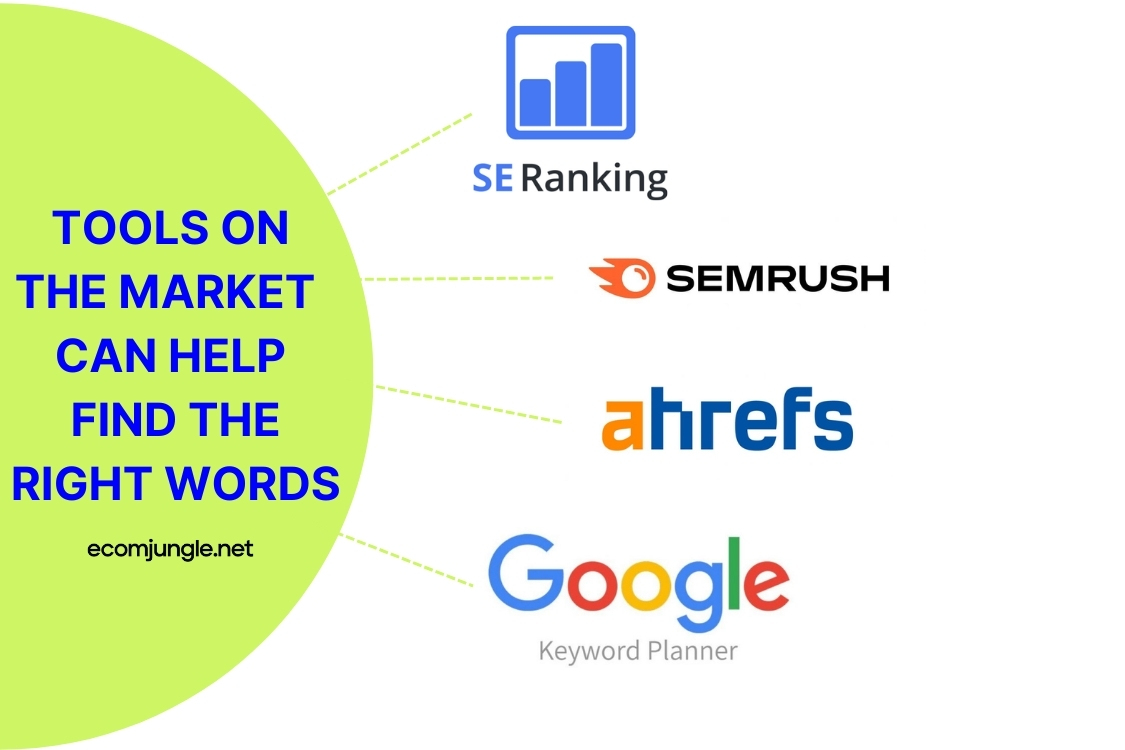
When choosing the right keywords for your product descriptions, what factors should you consider?
- Search volume per month: you need to select words that people frequently use in their queries to generate traffic.
- Competition level: check how difficult it will be for you to rank for that keyword, the more sites that use that keyword, the more difficult it will be for you to reach the top.
- Check what keywords your competitors use: if you need help figuring out where to start your keyword research, looking at your competitors’ search terms can help you find ideas for your content.
As you can see, product description writing demands you to focus not only on persuading customers but help them find your site easily.
Are you interest in learn what to do next after your keyword research?
Some Things to Remember When Writing Product Descriptions

After reading these ten critical rules for writing product descriptions, if you have doubts or need to supplement the information, here are some practical tips to get you started on your product pages.
- Create light and specific content.
- Use bullet points to highlight important details.
- Focus on the benefits and not on the technical characteristics of the product.
- Use expressive words.
- Tell the story of the product.
- Try to touch the heartstrings of your audience.
- Include keywords for your niche.
- Highlight the benefits of your products for the buyer.
- Use easy-to-understand phrases.
- Try to answer the questions that consumers will have about your product.
- Include pain points.
- Try to keep the text brief.
- Do not include exaggerated phrases.
- Include attractive page titles.
- Add high-quality product images and videos.
- Focus on your audience.
- Include comments and reviews from your previous customers.
- If you can, include a satisfaction guarantee.
Pro Tip:
Think about creating good blog posts explaining the value and usefulness of your products to complement your product pages.
Final Thoughts!
Have you noticed that all brands have their characteristic voice?
You don’t have to copy what others do; instead, be inspired to create your product description with the voice you want for your brand. If you use a product description template, at least try to personalize it as much as possible.
Avoid using clichés.
The adjectives, similes, and metaphors have been used so much that they have lost all meaning. Instead, use suggestive and power words that resonate with your audience.
Focus on the product’s critical benefits in your product description and avoid mundane features.
Talk with your potential buyers as if you are with them face to face.
If you still need help finding inspiration, I suggest you learn more about AI writing software to master product description writing.
Do you have any questions about creating your product pages? Want to know more about how to create SEO-friendly content?
Share your opinion in the comments!
Frequently Asked Questions
Product or service descriptions are brief texts that explain the characteristics and particularities of the products or services offered online. They are part of the product data sheet and deliver information to the consumer, such as ways of use, measures, materials, colors, etc.
Clear and direct title.
Tell a story.
Mention the problem.
Highlight the benefits.
Teaches how to use it
Appeals to the customer’s feelings with certain words.
Call to action.
Yes, product descriptions can be crucial in your SEO efforts and content marketing campaigning; they can help your potential customers reach your online store easily; a starting point can be adding keywords.